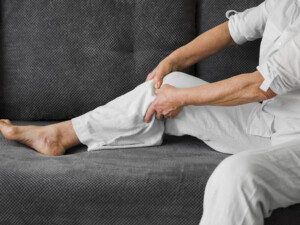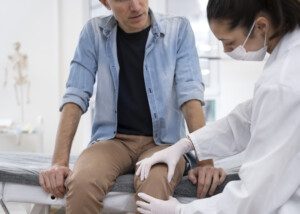A study showed that changing the way you walk was as effective as strong painkillers in reducing the pain of knee osteoarthritis.
It’s one of the most common causes of mobility impairment: osteoarthritis in the knees.
The disease gradually erodes the cartilage that cushions joints, and at present there is no treatment to reverse that damage (i.e., regrow lost cartilage).
Current care focuses on easing symptoms with medication until a joint replacement becomes necessary.
Joint replacements aren’t as durable as the healthy real thing, but they are game changers to patients.
A new line of research, however, suggests another path forward: gait retraining.
Scientists at the University of Utah, New York University, and Stanford University, conducted a year-long randomized controlled trial to test whether small changes in walking patterns could make a difference.
By slightly adjusting the angle of their feet while walking, participants achieved pain relief similar to what medication provides — and, importantly, they showed less cartilage deterioration in the knee than did participants who received a placebo intervention.
The findings, published in The Lancet Rheumatology (2025) and co-led by Scott Uhlrich of Utah’s John and Marcia Price College of Engineering, mark the first placebo-controlled trial to confirm that a biomechanical approach can effectively reduce osteoarthritis symptoms.
Greater forces on the knee accelerate the disease of osteoarthritis, states the paper.
Uhlrich explains that adjusting the foot angle can reduce those forces.
With support from the NIH and other federal agencies, the team focused on patients with mild or moderate osteoarthritis in the medial compartment of the knee.
This is the inner portion that carries most of the load.
Because each individual’s natural gait is different, the optimal foot angle adjustment also varies.
Earlier studies applied the same intervention across all patients, which sometimes failed to reduce knee stress — or even increased it.
This study instead customized the adjustment for each participant.
How the Study Was Done
At the start, participants received an MRI scan and practiced walking on a treadmill outfitted with pressure sensors and motion capture cameras.
This allowed researchers to determine whether pointing the toes inward or outward — and by 5° or 10° — best reduced knee loading.
Those who could not achieve any reduction in load were screened out, eliminating a confounding factor in past trials.
Sixty-eight participants were randomly assigned to either the experimental group or a sham group, where prescribed “adjustments” were identical to their natural gait.
During six weeks of supervised training, real-time biofeedback (via shin-mounted vibration devices) helped participants maintain their new walking pattern.
They were then encouraged to practice daily until the modified gait became second nature.
The Results
After one year, participants reported pain outcomes that ranged between the effects of common over-the-counter painkillers and stronger narcotics.
MRI scans confirmed slower cartilage degeneration in the intervention group.
Because osteoarthritis can mean decades of pain management before joint replacement becomes an option, especially for younger patients, gait retraining may offer a much needed bridge in care.
Applications in Real Life
For clinical adoption, the method will need to become less resource intensive.
Motion capture technology is costly and impractical outside research labs.
Uhlrich and colleagues envision that future patients might receive personalized prescriptions in a physical therapy setting, perhaps using smartphone video analysis or “smart shoes” with built-in sensors.
Additional studies will be necessary before the science from this study can be made widely available.
![]()
Lorra Garrick is a former personal trainer certified by the American Council on Exercise. At Bally Total Fitness, where she was also a group fitness instructor, she trained clients of all ages and abilities for fat loss and maintaining it, muscle and strength building, fitness, and improved cardiovascular and overall health.
.









































